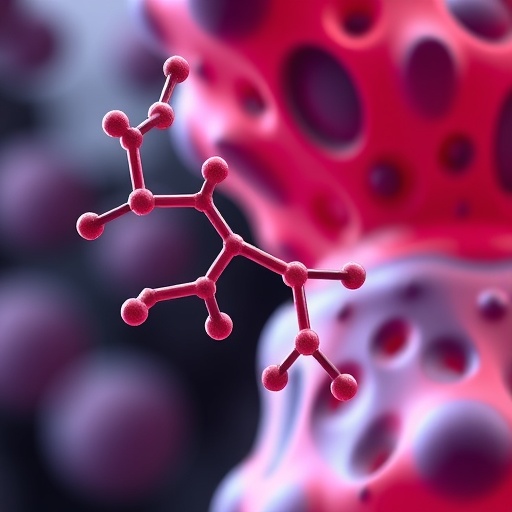In the relentless pursuit of effective cancer therapies, pyrazolo[3,4-d]pyrimidine-based dual inhibitors have emerged as a promising innovation. Recent studies, particularly those conducted by Jiang, H., Li, N., Qin, R. and their colleagues, delve into the intricate mechanisms and therapeutic potentials of these compounds, highlighting their capacity to target multiple cellular pathways involved in cancer progression. As scientists gain a deeper understanding of cancer biology, the necessity for multi-targeted approaches becomes increasingly clear, a need that pyrazolo[3,4-d]pyrimidine compounds are adept at addressing.
These dual inhibitors represent a fascinating intersection of medicinal chemistry and pharmacology, showcasing not only their ability to inhibit key enzymatic activities within cancer cells but also their potential to modulate various signaling pathways. One significant advantage of pyrazolo[3,4-d]pyrimidines is their versatility, which allows for the design of complex molecules that can engage multiple targets simultaneously. This dual action can potentially overcome some of the limitations associated with single-target inhibitors, such as the development of drug resistance, which often plagues conventional cancer therapies.
The scientific community is particularly excited about the mechanistic insights provided by these compounds, as they elucidate how pyrazolo[3,4-d]pyrimidines interact with molecular targets at a biochemical level. Studies have shown that these inhibitors can affect crucial pathways such as those driven by PI3K/AKT and MAPK, which are integral to cell growth and survival. By disrupting such pathways, pyrazolo[3,4-d]pyrimidines can induce apoptosis in malignant cells, making them a vital area of exploration in cancer medicine.
Moreover, their efficacy extends beyond mere enzymatic inhibition. Recent research indicates that these compounds also exhibit the ability to promote immune responses against tumors, thus potentially functioning as immunomodulatory agents. This dual capability not only highlights their relevance as anti-cancer therapeutics but also proposes an exciting avenue for immunotherapy integration, which is garnering increasing attention in oncological research. By harnessing the body’s immune system alongside targeted molecular strategies, pyrazolo[3,4-d]pyrimidine compounds hold promise for enhancing the effectiveness of existing cancer treatments.
Clinical studies underscore the significance of pyrazolo[3,4-d]pyrimidine-based dual inhibitors. Emerging data inform us that these agents can be particularly effective in treating cancers with specific genetic mutations, further increasing their utility as personalized treatment options. By tailoring therapies based on individual genetic profiles and tumor characteristics, clinicians can optimize treatment plans and improve patient outcomes. This personalized approach is crucial in an era where one-size-fits-all treatment strategies are increasingly recognized as inadequate.
As research progresses, the structure-activity relationship (SAR) of pyrazolo[3,4-d]pyrimidine derivatives continues to be a primary focus. Scientists are investigating how slight modifications to chemical structures can significantly affect biological activity, pharmacokinetics, and toxicity profiles. This meticulous optimization process is key to developing not only more potent inhibitors but also drugs with favorable safety profiles, as the side effects often associated with traditional chemotherapies remain a critical barrier to effective cancer care.
The synthesis of these complex molecules posed challenges that have led to significant advancements in synthetic methodologies. Innovative techniques now enable scientists to create pyrazolo[3,4-d]pyrimidine derivatives more efficiently and with greater precision, ensuring a steady pipeline of new candidates for preclinical and clinical testing. This synthetic versatility has important implications for scaling up production, allowing for more widespread application in laboratory settings and potentially leading to a faster transition to clinical use.
Furthermore, the integration of computational methods, such as molecular docking studies and machine learning algorithms, significantly enhances drug design efforts. By predicting how different compounds will interact with their targets, researchers can streamline the discovery process of new pyrazolo[3,4-d]pyrimidine inhibitors. With these advanced tools, scientists can identify promising candidates much earlier in the development phase, thus accelerating the timeline from bench to bedside.
As these dual inhibitors make their way through clinical trials, the anticipation surrounding their potential impact on patient management continues to grow. Early-phase trials have already indicated promising outcomes, yet the broader implications for metastatic cancers still require rigorous investigation. If results align with current expectations, pyrazolo[3,4-d]pyrimidines could very well alter the therapeutic landscape for various malignancies.
The future of pyrazolo[3,4-d]pyrimidine research looks particularly bright as an increasing number of interdisciplinary collaborations arise. The synthesis of medicinal chemistry, molecular biology, and clinical insights creates a robust framework for innovation. By fostering environments where information and expertise can flow freely between disciplines, researchers are better equipped to tackle the multifaceted challenges posed by cancer.
In conclusion, the advances in pyrazolo[3,4-d]pyrimidine-based dual inhibitors underscore a significant evolution in cancer therapeutics. By addressing the multifactorial nature of cancer with sophisticated, multi-targeted strategies, these compounds exemplify a promising frontier in oncology. Their ability to inhibit key pathways while potentially activating immune responses positions them as a game-changer in cancer treatment. As research delves deeper into their efficacy and applications, the hope is that these innovative agents will lead to improved outcomes for patients battling various forms of cancer.
As the scientific community continues to unveil the potential of pyrazolo[3,4-d]pyrimidines, it is an exciting era for oncology, filled with possibilities that may change the way we understand and treat one of humanity’s most challenging adversaries. With ongoing research and clinical trials, the hope is that these dual inhibitors will soon become an integral part of the cancer treatment arsenal, offering new hope for patients and their families.
Subject of Research: Pyrazolo[3,4-d]pyrimidine-based dual inhibitors in cancer treatment
Article Title: Recent advances in Pyrazolo[3,4-d]pyrimidine-based dual inhibitors in the treatment of cancers
Article References:
Jiang, H., Li, N., Qin, R. et al. Recent advances in Pyrazolo[3,4-d]pyrimidine-based dual inhibitors in the treatment of cancers. Mol Divers (2025). https://doi.org/10.1007/s11030-025-11379-0
Image Credits: AI Generated
DOI: 10.1007/s11030-025-11379-0
Keywords: Pyrazolo[3,4-d]pyrimidine, dual inhibitors, cancer treatment, immunotherapy, mechanistic insights, structure-activity relationship, clinical trials, synthetic methodologies.




